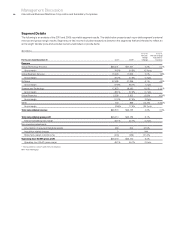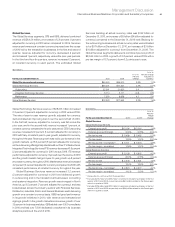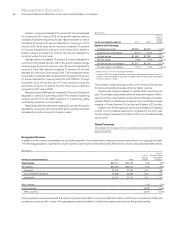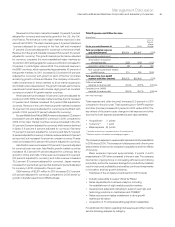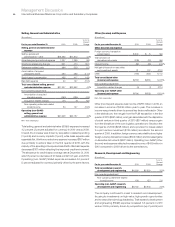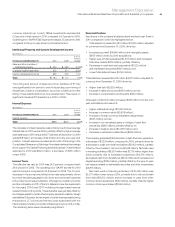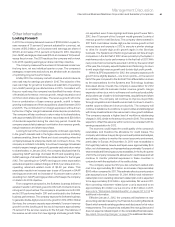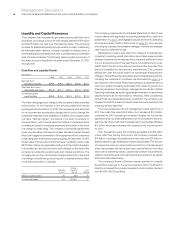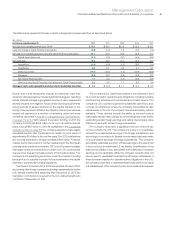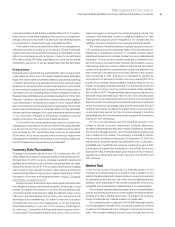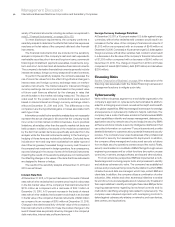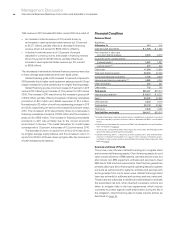IBM 2011 Annual Report Download - page 57
Download and view the complete annual report
Please find page 57 of the 2011 IBM annual report below. You can navigate through the pages in the report by either clicking on the pages listed below, or by using the keyword search tool below to find specific information within the annual report.
55
Management Discussion
International Business Machines Corporation and Subsidiary Companies
Other Information
Looking Forward
In 2011, the company delivered revenue of $106.9 billion, a year-to-
year increase of 7.1 percent (3 percent adjusted for currency), net
income of $15.9 billion, up 6.9 percent and earnings per share of
$13.06, an increase of 13.4 percent compared to 2010. Operating
(non-GAAP) earnings per share was $13.44, an increase of 15.2 percent
versus the prior year. The 2011 results put the company well on track
to its 2015 operating earnings per share road map objective.
The company measures the success of its business model over
the long term, not any individual quarter or year. The company’s
strategies, investments and actions are all taken with an objective
of optimizing long-term performance.
In May 2010, the company met with investors and introduced a
new road map for earnings per share in 2015. The objective of the
new road map for growth is to achieve at least $20 of operating
(non-GAAP) earnings per diluted share in 2015. Consistent with
the prior road map, the company has identified the major drivers
of financial performance: revenue growth, margin expansion and
common stock share repurchase. The revenue growth will come
from a combination of base revenue growth, a shift to faster
growing businesses and from acquisitions closed between 2010
and 2015. The contribution from margin expansion will be driven
by the mix of higher margin businesses and enterprise productivity.
The company will also continue to return value to its shareholders,
with approximately $50 billion of share repurchase and $20 billion
of dividends expected during the road map period. Overall, the
company expects fairly balanced contribution from revenue growth,
margin expansion and share repurchase.
Looking forward, the company expects continued opportunity
in the growth markets and in the higher value solutions, including
business analytics, Smarter Planet and cloud computing, where the
company believes its enterprise clients will continue to focus. The
company is confident in its ability to continue to leverage its business
model to expand margin, grow profit, generate cash and return value
to shareholders. In January 2012, the company disclosed that it is
expecting GAAP earnings of at least $14.16 and operating (non-
GAAP) earnings of at least $14.85 per diluted share for the full year
2012. The operating (non-GAAP) earnings per share expectation
excludes acquisition-related charges of $0.43 per share and non-
operating retirement-related costs of $0.26 per share. This
expectation results in an increase year to year of 8 percent in GAAP
earnings per share and an increase of 10 percent year to year in
operating (non-GAAP) earnings per share which keeps the company
on track to its 2015 objective.
From a segment perspective, the Software business delivered
excellent results in 2011 and goes into 2012 with momentum and a
strong set of opportunities. The company’s acquisitions in both 2010
and in 2011 performed well in 2011 and contributed to the Software
business performance. The company expects the Software business
to generate double-digit pre-tax income growth in 2012. Within Global
Services, the company expects approximately 3 percent revenue
growth from the backlog and this would represent approximately
70 percent of the services revenue for the full year. The balance of
the revenue would come from new signings and base growth. While
not expected, even if new signings and base growth were flat in
2012, then 70 percent of the 3 percent would generate 2 points of
revenue growth in total Services. The company demonstrated in
2011 that it could deliver double-digit pre-tax income growth on that
revenue base and expects in 2012 to execute a similar strategy
to drive for double-digit profit growth again in the Services
business. The Systems and Technology business will face a tough
comparison in the first half of 2012 driven primarily by the System z
mainframe product cycle performance in the first half of 2011. With
new product announcements expected in 2012, by the second half
of the year, the company expects Systems and Technology to return
to mid single-digit revenue growth and double-digit profit growth.
Within its EPS expectation for 2012, the company expects profit
growth to be slightly skewed—one to two points—in the second
half of the year compared to the first half. This differentiation is driven
by the expectations for the Systems and Technology business
discussed above. Overall, the company’s expectation for 2012
is consistent with its business model: revenue growth, margin
expansion driven by a mix to software and continued productivity
and prudent use of cash to drive investments, acquisitions and share
repurchase. The company will continue to improve its portfolio
through acquisitions and divestitures and will continue to invest in
market opportunities and drive productivity. The company will
continue to rebalance its workforce to opportunities and skills aligned
with its key investments and hire resources to drive growth initiatives.
The company expects a higher level of workforce rebalancing
charges in 2012, similar to the amount incurred in 2010. The company
expects to offset this expense within net income consistent with its
earnings expectation for 2012.
The economy could impact the credit quality of the company’s
receivables, and therefore the allowance for credit losses. The
company will continue to apply its rigorous credit policies and analysis,
and will also continue to monitor the current economic environment,
particularly in Europe. At December 31, 2011, total receivables in
Portugal, Italy, Ireland, Greece and Spain were approximately $2.6
billion, net of allowances, and represented approximately 7 percent of
total net trade and financing accounts receivables. In the fourth quarter
of 2011, the company increased its allowance for credit losses and will
continue to monitor potential exposures in these countries in
conjunction with the application of its credit policies.
The company expects 2012 pre-tax retirement-related plan
cost to be approximately $2.3 billion, an increase of approximately
$500 million compared to 2011. This estimate reflects current pension
plan assumptions at December 31, 2011. Within total retirement-
related plan cost, operating retirement-related plan cost is expected
to be approximately $1.9 billion, approximately flat versus 2011.
Non-operating retirement-related plan cost is expected to be
approximately $0.4 billion versus income of $0.1 billion in 2011.
See note S, “Retirement-Related Benefits,” on pages 121 to 135 for
additional information.
Effective January 1, 2012, the company will implement a new
accounting standard issued by the Financial Accounting Standards
Board which amends existing guidance and disclosure for fair value
measurements. The company has evaluated the new guidance and
does not expect a material impact on the consolidated financial results.
See note B, “Accounting Changes,” on page 87 for additional information.



